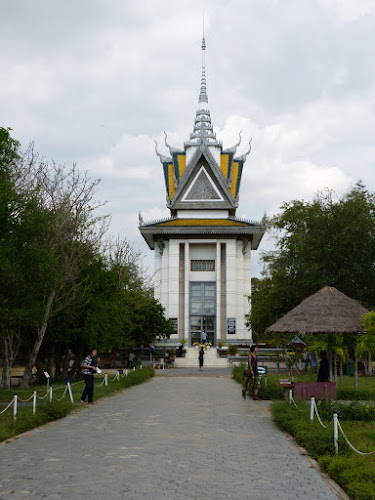On March 8 -- International Women's Day -- we sailed into Cambodia. In Phnom Pen, the capital city, our education about Pol Pot's sadistic regime began. The Khmer Rouge seized power in 1975 and swiftly forced Communist rule upon the Cambodian people. In Phnom Pen, teachers, lawyers, Buddhist monks and anyone believed to be loyal to the previous democratic regime were rounded up and executed. Families were forced to leave their homes and move to the countryside, most often on foot and carrying what they could. Those who walked too slow were simply shot. Our guide Ry (pronounced "rEE") was a young boy when he left his neighborhood and walked into the countryside, gathering grim memories as he witnessed beatings and suffering along the way.
Pol Pot's goal was to establish an ideal agrarian society by making the population into farmers. Economically, it didn't make sense, but with Marxist principles guiding the regime and with assistance coming from Vietnamese operatives, Pol Pot (a nickname the dictator took which is a shortening of "political potential") pushed forward, always manipulating things from the background. In time, the Khmer Rouge became systemically paranoid, obsessed with killing anyone who didn't adhere to the rules.
It is estimated that 7 million Cambodians died between 1975 and 1979. While many died of starvation and disease in the Khmer Rouge work camps, most died in the killing fields of which there were several across the country.
The killing field of Choeung Ek, a former Chinese cemetery, is located 15 kilometers from the centre of Phnom Pen. Prisoners were brought here by truck and killed immediately unless there were too many, in which case they were housed in a darkened wooden building overnight. The horror of waiting for certain death must have been terrible.
In the centre of the site now stands a sad memorial with glass compartments holding hundreds of skulls, the remains of the victims. In the Buddhist faith, the head is the seat of knowledge and wisdom. In death the ohead is essential to finding one's way to the next reincarnation. It is especially poignant that these skulls now have a safe resting place.
As the rains come, bones, teeth and clothing emerge from the clay soil. Custodians at the site gather and keep everything. Just as we heard this, we glanced down to see these remains there at our feet. It could make you weep to think of the fear and suffering of those who were brought here. They were not shot. Their throats were slit or they were bludgeoned to death and shoved into a mass grave. DDT was spread to mask the smell of decay and eliminate insects. The horror of it is impossible to fathom.
Below, a loudspeaker was mounted on this tree to play loud music to mask the screams of the victims.
So why did we go to this place? The Khmer Rouge regime is part of the story of Cambodia. This genocide happened in our lifetime, although we were barely aware of it. It felt necessary to bear witness to the suffering of the Cambodian people.
Bracelets are left on a fence, each in memory of a lost loved one.
Note: Pol Pot's real name was Sa lit Sor. He died in 1998, but his body was burned and then buried. There are those in Cambodia who doubt he really died.







No comments:
Post a Comment